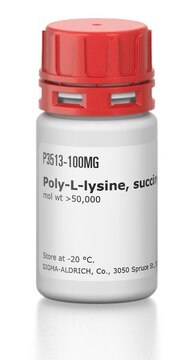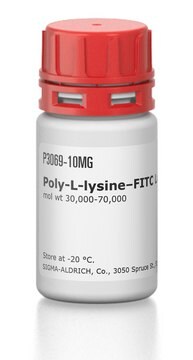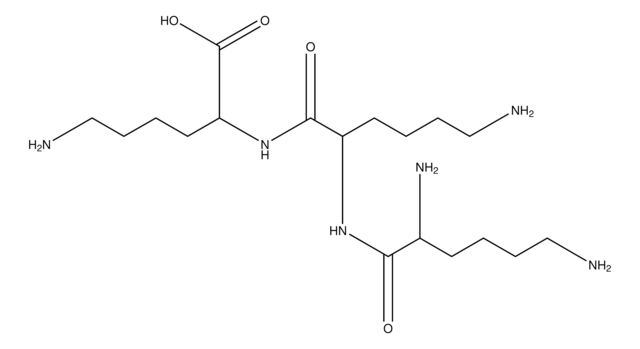P4510
Poly-ε-Cbz-L-lysine
mol wt 500-4,000
Sinônimo(s):
N6-[(phenylmethoxy)carbonyl]-L-lysine homopolymer
About This Item
Produtos recomendados
Formulário
powder
Nível de qualidade
peso molecular
500-4,000
cor
white
temperatura de armazenamento
−20°C
InChI
1S/C14H20N2O4/c15-12(13(17)18)8-4-5-9-16-14(19)20-10-11-6-2-1-3-7-11/h1-3,6-7,12H,4-5,8-10,15H2,(H,16,19)(H,17,18)/t12-/m0/s1
chave InChI
CKGCFBNYQJDIGS-LBPRGKRZSA-N
Procurando produtos similares? Visita Guia de comparação de produtos
Aplicação
- Transfection by polyethyleneimine-coated microspheres.: This study explores the use of Poly-e-Cbz-L-lysine in coating microspheres with polyethyleneimine for enhanced cell transfection, demonstrating improved efficiency and potential applications in gene therapy (Manuel WS et al., 2001).
- Transfection of cells mediated by biodegradable polymer materials with surface-bound polyethyleneimine.: The research focuses on biodegradable polymer materials, including Poly-e-Cbz-L-lysine, for cell transfection, highlighting their biodegradability and effectiveness in delivering genetic material (Zheng J et al., 2000).
- Production of microspheres with surface amino groups from blends of Poly(Lactide-co-glycolide) and Poly(epsilon-CBZ-L-lysine) and use for encapsulation.: This paper discusses the creation of microspheres with surface amino groups using blends of Poly-e-Cbz-L-lysine, which are then used for encapsulating active agents, indicating applications in drug delivery systems (Zheng J et al., 1999).
- Modification of materials formed from poly(L-lactic acid) to enable covalent binding of biopolymers: application to high-density three-dimensional cell culture in foams with attached collagen.: The study examines the modification of poly(L-lactic acid) materials with Poly-e-Cbz-L-lysine to covalently bind biopolymers, facilitating high-density 3D cell culture applications (Zheng J et al., 1998).
Nota de análise
Outras notas
Código de classe de armazenamento
11 - Combustible Solids
Classe de risco de água (WGK)
WGK 3
Ponto de fulgor (°F)
Not applicable
Ponto de fulgor (°C)
Not applicable
Equipamento de proteção individual
Eyeshields, Gloves, type N95 (US)
Escolha uma das versões mais recentes:
Já possui este produto?
Encontre a documentação dos produtos que você adquiriu recentemente na biblioteca de documentos.
Os clientes também visualizaram
Artigos
Humankind has utilized protein materials throughout its existence, starting with the use of materials such as wool and silk for warmth and protection from the elements and continuing with the use of recombinant DNA techniques to synthesize proteins with unique and useful properties.
Nossa equipe de cientistas tem experiência em todas as áreas de pesquisa, incluindo Life Sciences, ciência de materiais, síntese química, cromatografia, química analítica e muitas outras.
Entre em contato com a assistência técnica






